Last Updated on July 6, 2022
“Man, that footrest feels amazing,” your buddy says with a grin, driving your mint-condition 1969 Porsche 911. You continue observing the open road until the thought hits you “this car doesn’t have a footrest.”
He was RIDING THE CLUTCH! Your heart stops. Imagine all the damage he could be doing!
Fear not, dear reader, for this isn’t as huge of a deal as some keyboard warriors make it out to be. Here’s a comprehensive look at riding the clutch
What Does the Clutch Pedal Do?
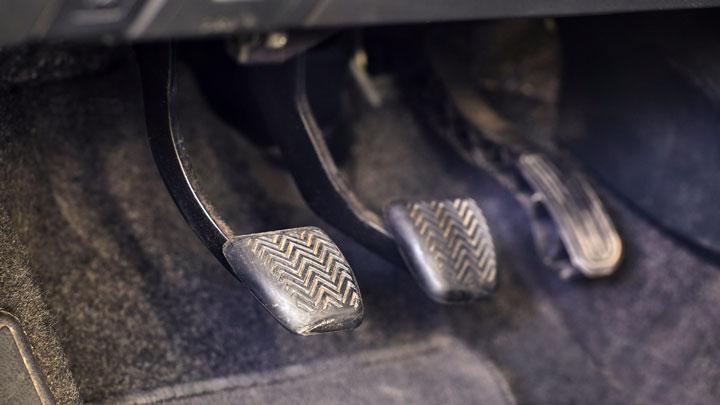
A clutch pedal is a lever to the left of your brake pedal that allows you to engage and disengage the “clutch” of your car in a smooth manner when you are changing gears. The clutch pedal is only available on cars with a manual transmission, so if the car in question doesn’t have one of these, you’re in luck!
When you press on the clutch pedal, the two plates that connect your engine to your driveshaft within your transmission disconnect, allowing you to select another gear to get going at a higher or lower rate of speed.
Most clutches are friction-based with varying degrees of friction that keep them together. When you depress the clutch pedal, these two plates will separate from each other, but will rub a little bit, which will cause some wear.
What Does “Riding the Clutch” Mean?

Riding the clutch means you are putting a little bit of pressure on the clutch pedal, but not pressing it down all the way. This means the clutch plates are barely separating, allowing some friction and motion to occur, causing premature wear on these plates.
Since clutches are considered “wear items” by pretty much everyone in the automotive industry, the replacement of this item will most likely not be covered under your new car’s warranty, so it could be a costly repair.
This is mostly due to labor, because you’ll need to take apart the transmission to replace the clutch, and then put everything back together, along with new fluids.
It’s important to know that all is not lost in the way of clutch pedal adjustment! You can definitely adjust the ‘play’ or freedom of your clutch pedal by following this helpful guide we’ve put together.
See Also: Is It Illegal to Drive Barefoot?
What Happens When You Ride the Clutch?
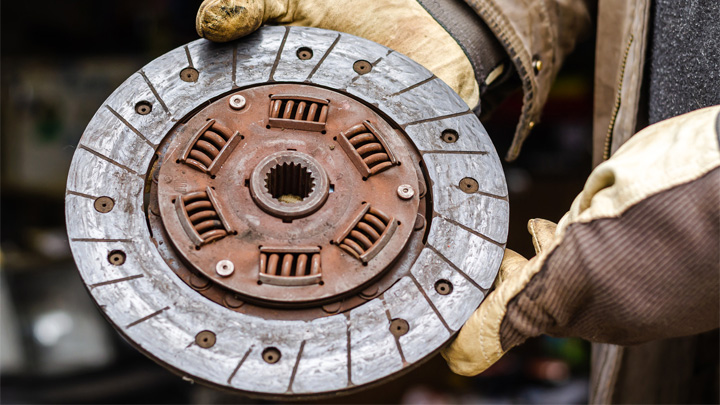
When you ride the clutch—barely depressing the clutch pedal, or when you rest your foot on the pedal—you are ever-so-slightly releasing the clutch discs, allowing them to slip and slide against each other.
As we know from high school physics, any sort of friction between two surfaces is going to result in some wear and tear. The same goes for clutches and their interaction with each other.
Now, I wanted to mention that you don’t have to ride the clutch if you are driving with two feet, although some seem to think it’s unavoidable. If you are the next drift king or the king of Tsukuba time attack events, I don’t need to be telling you this.
Check out that article and then leave a comment to tell us why we're wrong. 😉
The downside of riding the clutch is that clutch jobs are expensive, but the upside of replacing your clutch is you can splurge for a more “performance-oriented” clutch or one that wears less-quickly.
There are plenty of options out there, but if you’re in the mood for car parts shopping, here’s where you should start: 19 Best Online Auto Parts Stores
See Also: Accidentally Driving With the Parking Brake On? (Here’s What Happens)
Is It Okay to Ride the Clutch in Traffic?
No. Try not to ride your clutch at any time.
If you find it really hard to not put your foot on the clutch pedal when you’re resting your foot, make sure you adjust your driving position so you can give your legs a bit more freedom in the footwell.
Another option is to wear driving shoes that give you more feedback from the vehicle itself. That way, you can tell more immediately how hard you’re pressing the clutch down when you’re driving. I’ll add that this hasn’t been tested, it’s just a thought.
Riding vs Slipping the Clutch
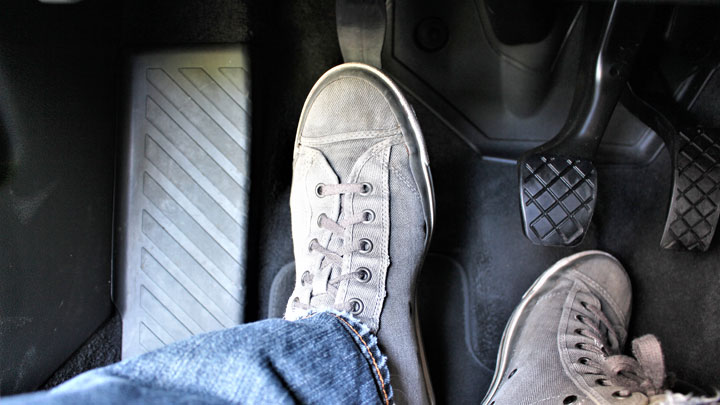
While riding and slipping the clutch are both essentially the same mechanism of wear, they are different in their application.
When you ride the clutch, it’s more of constant, incessant friction that’s placed on the two clutch plates over and over again. This means they will wear down slowly over time, and you’ll have to replace them eventually.
While similar, “slipping” the clutch is a necessary part of driving a manual transmission car—and I’m not talking about doing a burnout.
When you need to accelerate quickly uphill without your car rolling backward, you’ll need to quickly release the clutch with power going to the transmission to allow your clutch to “slip”, making the wheels chirp a little bit—but at the same time preventing your car from rolling backward into another car.
This is handy because you don’t want to cause a fender bender and become liable for all the damage that ensues.
How to Stop This Bad Driving Habit
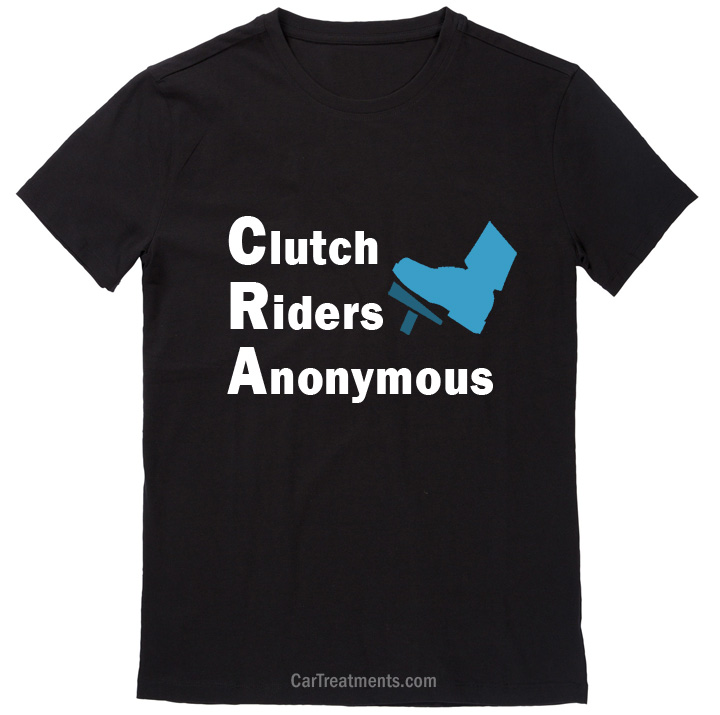
While there isn’t a “Clutch Riders Anonymous” (CRA shirts anyone???) group out there that I know of, there are a couple of proven ways to break a habit.
First, write it down. Then, try to pay more attention when you’re driving to where your feet are placed in the footwell. If you need to adjust your setting posture, go ahead and do that.
If you need to place a sticky note on the steering wheel with the reminder “Don’t Ride the Clutch” on it, then go ahead and do that! In any case, just by getting to the end of this article, you’re already doing better than a lot of others out there, so just be mindful!

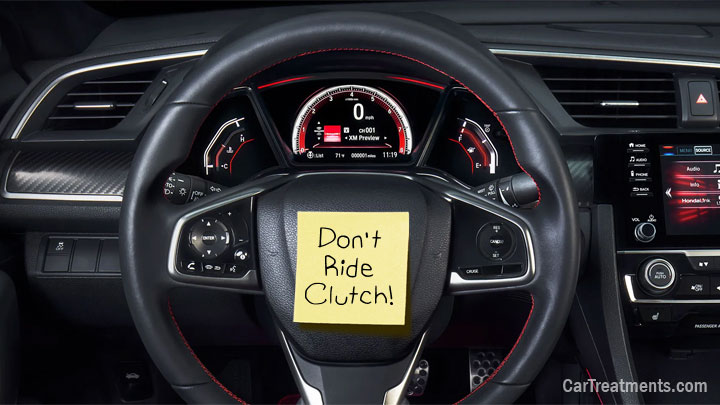



Some manual transmission vehicles actually do have paddles. For instance, the C7 Corvette has paddles to toggle the auto rev matching feature. https://www.roadandtrack.com/new-cars/news/a3764/2014-chevrolet-corvette-stingray-has-manual-shifter-and-steering-wheel-paddles/